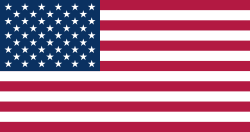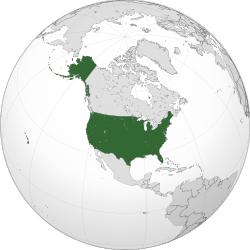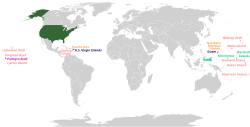United States of America | |
|---|---|
| Motto: "In God We Trust" Other traditional mottos:
| |
| Anthem: "The Star-Spangled Banner" | |
| Capital | Washington, D.C. 38°53′N 77°1′W / 38.883°N 77.017°W |
| Largest city | New York City 40°43′N 74°0′W / 40.717°N 74.000°W |
| Official languages | None at the federal level |
| National language | English |
| Ethnic groups (2020) | By race:
By origin:
|
| Religion (2023) |
|
| Demonym(s) | American |
| Government | Federal presidential republic |
| Donald Trump | |
| JD Vance | |
| Mike Johnson | |
| John Roberts | |
| Legislature | Congress |
| Senate | |
| House of Representatives | |
| Independence from Great Britain | |
| July 4, 1776 | |
| March 1, 1781 | |
| September 3, 1783 | |
| June 21, 1788 | |
| Area | |
Total area | 3,796,742 sq mi (9,833,520 km2) (3rd) |
Water (%) | 7.0 (2010) |
Land area | 3,531,905 sq mi (9,147,590 km2) (3rd) |
| Population | |
2024 estimate | |
2020 census | |
Density | 87/sq mi (33.6/km2) (185th) |
| GDP (PPP) | 2024 estimate |
Total | |
Per capita | |
| GDP (nominal) | 2024 estimate |
Total | |
Per capita | |
| Gini (2023) | medium inequality |
| HDI (2022) | very high (20th) |
| Currency | U.S. dollar ($) (USD) |
| Time zone | UTC−4 to −12, +10, +11 |
Summer (DST) | UTC−4 to −10 |
| Date format | mm/dd/yyyy |
| Calling code | +1 |
| ISO 3166 code | US |
| Internet TLD | .us |
Table of Contents
Introduction to Trademark Counterfeiting
Trademark counterfeiting is the unauthorized use of a registered trademark or a substantially indistinguishable mark on goods or services, typically with the intent to deceive consumers and boost profits illegally. This act represents a serious threat to brand integrity and consumer trust, as it undermines the hard-earned goodwill associated with legitimate products. Counterfeiting not only creates financial losses for trademark owners but also poses health and safety risks to consumers who may unwittingly purchase inferior imitations of original products.
The significance of trademark counterfeiting in the business world is underscored by its prevalence. According to reports from the International Chamber of Commerce, the global economic value of counterfeit goods is estimated to exceed $3 trillion annually. This staggering figure highlights the widespread nature of counterfeiting and its impact across various sectors, including fashion, electronics, and pharmaceuticals. For instance, high-profile cases involving counterfeit luxury handbags or fake pharmaceuticals have demonstrated how deeply rooted the issue is within markets. Such incidents lead to a decrease in consumer confidence, ultimately affecting the sales and reputation of the legitimate brands.
Counterfeit products can lead consumers to believe they are purchasing authentic items, resulting in financial losses that may also impact the broader economy, as businesses face heightened competition from unscrupulous actors. Moreover, statistics indicate that small and medium-sized enterprises are particularly vulnerable, often lacking the resources to combat counterfeiters effectively. As a response to this crisis, it is imperative for trademark owners to understand the anti-counterfeiting measures available to them. By proactively addressing the threat of counterfeiting, businesses can safeguard their trademarks and ensure the protection of consumers against counterfeit goods.
Understanding the Legal Framework
The protection of trademarks in the United States is primarily founded upon a comprehensive legal framework that includes both federal and state laws. The Lanham Act, formally known as the Trademark Act of 1946, forms the cornerstone of trademark protection at the federal level. This legislation not only defines what constitutes a trademark but also articulates the legal rights that trademark owners hold. Under the Lanham Act, trademark owners can seek recourse against any unauthorized use of their trademarks that may cause confusion among consumers or dilute the distinctiveness of their brand.
In addition to the Lanham Act, the United States Patent and Trademark Office (USPTO) plays a crucial role in enforcing and administering trademark laws. The USPTO is responsible for the registration of trademarks, providing agencies with the necessary tools to protect their intellectual property rights effectively. Once a trademark is registered with the USPTO, the owner obtains a presumption of validity, which affords them stronger legal protections against potential infringers.
Anti-counterfeiting measures are closely linked to these legal protections. Trademark owners facing threats from counterfeit goods can utilize the remedies outlined in the Lanham Act, including monetary damages and injunctive relief. These remedies empower brand owners to take decisive action against counterfeiters, safeguarding their reputation and market position. Furthermore, the law offers a range of protective measures, including the ability to file lawsuits in federal court, which can serve as a deterrent against potential infringers.
Overall, understanding the legal framework surrounding trademark protection is essential for trademark owners. It not only delineates their rights but also informs them about the requisite steps they can take to combat counterfeiting effectively. Through leveraging these legal avenues, trademark owners can mitigate the risks associated with counterfeit goods and uphold the integrity of their brands.
Anti-Counterfeiting Strategies and Tools
Counterfeiting poses a significant threat to trademark owners across various industries, necessitating the implementation of effective anti-counterfeiting strategies. Businesses can employ a range of methods to combat this growing issue, focusing on product authentication, secure supply chains, and advanced technologies. Each of these approaches plays a crucial role in safeguarding intellectual property and ensuring brand integrity.
One fundamental approach is product authentication, which involves verifying the legitimacy of goods before they reach consumers. This can be achieved through various means, such as holographic labels, QR codes, or watermarks. By incorporating unique identifiers, brand owners can empower consumers to distinguish authentic products from counterfeit ones. These measures not only build trust with customers but also serve as deterrents against forgers who may find it more challenging to replicate intricate features.
Secure supply chain practices are another critical component of anti-counterfeiting strategies. Establishing robust relationships with suppliers, manufacturers, and distributors ensures that every stage of the production and distribution process is monitored. Companies can conduct regular audits and inspections to minimize vulnerabilities, thereby reducing opportunities for counterfeit products to infiltrate their supply chains. Collaboration with law enforcement and regulatory agencies further enhances efforts to investigate and dismantle counterfeit networks.
Moreover, advancements in technology present innovative solutions to combat counterfeiting effectively. Technologies such as Radio Frequency Identification (RFID) and blockchain offer valuable tools for tracking and verifying products throughout their lifecycle. RFID tags can provide real-time data about a product’s location and authenticity, while blockchain technology ensures secure, transparent record-keeping, making it almost impossible for counterfeit goods to go undetected. By integrating these technologies into their operations, trademark owners can not only bolster their defenses against counterfeiting but also enhance overall efficiency.
Monitoring and Enforcement Techniques
Monitoring trademark usage plays a critical role in a trademark owner’s strategy to protect their intellectual property rights. The proactive approach to identifying potential infringements ensures that trademark owners maintain their brand integrity and prevent consumer confusion in the marketplace. Implementing effective monitoring techniques not only helps in discovering unauthorized use of trademarks but also facilitates timely action to enforce their rights.
One effective method for monitoring is to conduct regular searches on online sales platforms. Major marketplaces like Amazon, eBay, and Alibaba can be prolific breeding grounds for counterfeit goods. Utilizing automated tools or services that specialize in tracking keyword usage and listing similarities can significantly streamline this process. Regularly scanning these platforms allows trademark owners to identify and report counterfeits swiftly, reducing the risk of consumer deception.
In addition to monitoring e-commerce platforms, leveraging social media plays a vital role in modern enforcement strategies. Trademark owners should actively engage with consumers on platforms like Facebook, Instagram, and Twitter, encouraging them to report potential infringements they encounter. Establishing branded hashtags can help facilitate this reporting process, making it easier to identify infringers. Furthermore, social media platforms often have their own reporting mechanisms designed to address intellectual property violations, providing an additional layer of enforcement.
Building collaborative relationships with customs officials and law enforcement agencies presents another avenue for effective trademark protection. By providing these entities with information about the trademark, including legal documentation and guidance on identifying genuine products, trademark owners can enable enforcement at borders. Customs officials are often the first line of defense against counterfeit goods entering the market, so equipping them with the necessary resources can aid in swiftly intercepting fraudulent items.
Overall, the interconnected strategies encompassing online monitoring, social media engagement, and collaboration with law enforcement agencies serve as a framework for trademark owners to actively enforce their rights, safeguard brand equity, and combat counterfeiting in an increasingly complex marketplace.
The Role of Customs and Border Protection (CBP)
U.S. Customs and Border Protection (CBP) plays a critical role in protecting the integrity of trademarks and preventing the importation of counterfeit goods into the United States. As the primary federal agency overseeing the enforcement of trade laws, CBP is responsible for inspecting goods entering the country and ensuring compliance with intellectual property rights. This includes identifying and seizing counterfeit products that infringe upon registered trademarks.
One of the essential functions of CBP is the management of the Trademark Recordation Program. Trademark owners can register their marks with CBP, which allows the agency to better recognize legitimate products and distinguish them from counterfeit items. By obtaining a recordation, trademark owners give CBP the necessary information to aid in the identification of potential violations, thereby facilitating the detection and seizure of counterfeit goods at U.S. borders.
The registration process with CBP requires trademark owners to submit specific documentation, including details of the trademark, ownership information, and the corresponding goods and services associated with the mark. Once registered, CBP utilizes advanced inspection techniques and intelligence-sharing networks to monitor and enforce trademark protections. This proactive approach not only aids in curbing the flow of counterfeit products but also helps maintain the reputation and economic interests of legitimate brands.
Importantly, the collaboration between trademark owners and CBP is vital for the effectiveness of anti-counterfeiting efforts. Trademark owners are encouraged to maintain ongoing communication with CBP, providing updated information regarding products, packaging, and any emerging counterfeit trends. This partnership enhances CBP’s ability to protect trademarks and provides trademark owners with a more robust defense against the threat of counterfeiting.
International Considerations and Global Enforcement
As businesses increasingly expand their reach into global markets, the risks associated with counterfeiting have also grown. Understanding international trademark protections is essential for U.S. trademark owners looking to safeguard their intellectual property. Various treaties and agreements have been established to create a framework for international cooperation in counteracting counterfeiting activities, including the Trade-Related Aspects of Intellectual Property Rights (TRIPS) agreement. This pivotal treaty sets minimum standards for intellectual property protections among its signatories, making it a foundational element in the global fight against counterfeit goods.
In navigating international enforcement, U.S. trademark owners must be aware that each jurisdiction may have differing laws and procedures regarding trademark rights and the enforcement of those rights against counterfeit products. While some countries may offer strong protections and efficient legal remedies, others may present significant challenges due to lax enforcement mechanisms or cultural norms that view counterfeiting less severely. Consequently, trademark owners must conduct thorough research on the legal landscapes of the regions in which they operate. This understanding enables them to make informed decisions about the best strategies for protecting their brands through local registration of trademarks, adherence to regional laws, and possible engagement with local legal counsel familiar with anti-counterfeiting measures.
Moreover, international enforcement often requires U.S. trademark owners to leverage diplomatic and trade avenues, cooperating with local governments and using resources such as the U.S. Commercial Service. By joining forces with local trade organizations, brands may also benefit from collaborative anti-counterfeiting efforts that combine resources and knowledge. As globalization continues to reshape commerce, trademark owners must be proactive in developing comprehensive international strategies that not only address the risks of counterfeiting but also ensure robust protections for their trademarks across diverse legal landscapes.
Using Technology to Combat Counterfeiting
The rise of digital technologies has significantly transformed the landscape of anti-counterfeiting measures. Specifically, advancements such as digital watermarking and artificial intelligence (AI) have emerged as vital tools for trademark owners in their battle against counterfeit products. Digital watermarking offers a unique method for embedding identifying information within products or packaging, enabling true owners to verify authenticity without altering the visible features. This technology not only enhances the security of the product but acts as a deterrent for counterfeiters who are aware that their fakes can be easily identified.
Moreover, AI-based tracking and monitoring systems have proven to be invaluable in identifying counterfeit goods across various platforms. These sophisticated systems analyze data patterns, consumer behavior, and transaction histories to highlight irregularities that may indicate the presence of counterfeit items. By employing machine learning algorithms, trademark owners can efficiently sift through vast amounts of data to detect and prevent counterfeit sales before they proliferate. This proactive approach enables a more rapid response to potential threats, reducing the overall impact of counterfeit goods on businesses and consumers alike.
E-commerce platforms have also started implementing strict policies to mitigate the sale of counterfeit items. Initiatives such as enhanced verification processes and machine learning tools for detecting suspicious listings are increasingly being adopted. By fostering a collaborative environment where brands can report infringements, these platforms are enhancing their efforts against counterfeiting effectively. Additionally, emerging technologies such as blockchain are being explored for their potential to provide secure, immutable records of product origin, thus ensuring supply chain integrity and traceability.
The integration of these technological measures forms a crucial part of an overarching strategy to combat counterfeiting. By leveraging digital advancements, trademark owners can enhance their capabilities to protect their intellectual property and maintain consumer trust. The landscape for protecting trademarks is continually evolving, fueled by innovation and technology.
Case Studies of Successful Anti-Counterfeiting Initiatives
In recent years, several trademark owners have successfully implemented anti-counterfeiting initiatives that serve as notable examples for others in the industry. One prominent case involves a well-known luxury fashion brand that identified a significant increase in counterfeit products being sold online. To combat this issue, the brand undertook a multifaceted approach that combined legal action, online monitoring, and consumer education. They engaged with e-commerce platforms to remove counterfeit listings and initiated legal proceedings against the manufacturers and sellers of these counterfeit goods. This strategy not only significantly reduced the availability of counterfeit products but also enhanced consumer confidence in the brand.
Another successful case highlights a leading electronics manufacturer that focused on intellectual property protection through technology. This company developed advanced tracking technologies embedded in their products, enabling them to verify authenticity upon consumer purchase. Furthermore, they launched an awareness campaign aimed at educating consumers on the risks associated with counterfeit electronics, including the potential for safety hazards. By integrating technology with an educational initiative, the manufacturer successfully minimized the risk of counterfeit products entering the market and established itself as a trusted leader in the electronics industry.
A third notable example features a global sports apparel company that utilized social media and influencer partnerships as part of its anti-counterfeiting strategy. Recognizing that counterfeiters often exploit online platforms, the brand collaborated with popular influencers to raise awareness about counterfeit products, illustrating the importance of purchasing from authorized retailers. The campaign not only helped to deter consumers from purchasing counterfeit items but also fostered a sense of community around the brand. Ultimately, by employing an innovative marketing strategy, they were able to pivot the narrative surrounding counterfeiting, encouraging consumer responsibility and loyalty. These case studies demonstrate that a combination of legal, technological, and educational strategies can be instrumental in successfully combating counterfeiting efforts.
Future Trends in Anti-Counterfeiting
The landscape of anti-counterfeiting measures is continuously evolving, driven by advancements in technology, shifts in consumer behavior, and ongoing legislative developments. Looking ahead, it is crucial for trademark owners to adapt to these changes to effectively protect their intellectual property and maintain brand integrity.
One significant trend is the integration of advanced technologies such as blockchain and artificial intelligence into anti-counterfeiting strategies. Blockchain technology offers a decentralized and immutable ledger that can authenticate products and track their origins, making it increasingly harder for counterfeit goods to infiltrate the market. Meanwhile, artificial intelligence can analyze vast amounts of data to identify and flag potential counterfeit operations in real-time, increasing enforcement efficiency. As these technologies mature, trademark owners should begin to consider how they can leverage them to safeguard their brands against counterfeiters.
Changes in consumer behavior also play a pivotal role in the future of anti-counterfeiting. The rise of digital marketplaces and online shopping has significantly expanded the scope of counterfeit activities. Consequently, consumers are becoming more aware of counterfeit risks, leading to an increasing demand for authenticity verification. Trademark owners may need to invest in educational campaigns that inform consumers about legitimate products while also implementing visible security features that will reassure customers of their purchases’ authenticity.
On the legislative front, there is likely to be an increased focus on strict regulatory measures aimed at combating counterfeiting. Governments are becoming more aware of the economic impact of counterfeit goods and may enact stronger laws and penalties against violators. Trademark owners should stay informed about these changes to ensure they comply with new regulations and take full advantage of available legal protections.
To remain competitive, trademark owners must be proactive in adapting their anti-counterfeiting strategies to reflect these future trends. By embracing technological innovations, understanding consumer expectations, and navigating legislative shifts, businesses will be better positioned to protect their trademarks and thwart the burgeoning counterfeit market.




